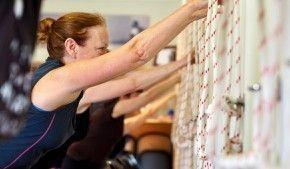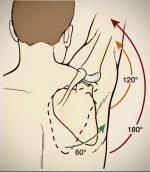Griffins Hill Retreat yoga and food blog
The tricky question of the shoulder blades
A question that regularly comes up in class regards where to position the shoulder blades when the arms are raised over the head.
Students are often unclear what to do with their shoulder blades and mistakenly believe that they should pull them down to free up the neck.
As a teacher, I observe that the common instruction to pull the shoulder blades down is not making sense to many yoga students because their experience tells them this movement does not necessarily improve alignment and can make it more difficult to raise the arms overhead
I'm writing this blog to clarify this because it's critical to understand how to move the shoulder blades correctly for three main reasons, as incorrect understanding:
• Limits the range of your movement in many poses
• Can lead to muscle and joint pain from over-stretching the arm
• May result in joint damage over time
A look inside our shoulder joints
You can see from the picture the effects of moving the shoulder blade incorrectly (centre image). When we raise our arms overhead the outer edge of the shoulder blade pivots up while the inner edge pivots down. The diagram below shows the difference between a rigid shoulder blade (centre) and when we allow the shoulder blade movement to integrate with the movement of the arm (right).
The above image illustrates the movement of the scapular and humerus when the arms are raised overhead called the Scapula humeral rhythm. As is clearly illustrated the shoulder blade rotates with the movement of the arm to increase its mobility.
This has clear implications in poses such as Adho Mukha Vrksasana (handstand). Without the correct alignment of the shoulder blade and humerus the shoulder joint is more vulnerable to dislocation.
The shoulder has far greater range of movent than just up and down it as can be:
• Elevated (as when shrugging shoulders)
• Depressed (moving shoulder blade down)
• Adducted (when we sqeeze them to the midline)
• Abducted (moving them laterally apart away from the spine)
• Upwardly rotated as when taking the arms overhead)
• Downwardly rotated as when moing arms down or behind back)
or a combination of the planes of movement
For further information view https://www.youtube.com/watch?v=rpzBGlOEW4E
Our amazing shoulder joint
The shoulder joint is the most flexible, mobile and complex joint in the human body. It can undergo a huge range of movement in all directions. This is a fantastic thing but also makes it one of the most unstable joints in the body.
I'd love to tell you all I know about the shoulder joint, but I would have to write an entire book (and I am going to recommend one at the end). So, for purposes of clarity, I want you to picture two joint actions. The first is the movement of the arm in the ball and socket, and the second is the movement of the shoulder blade.
What we want to happen is for these two movements complement each other.
How we achieve this varies according to the asana (yoga pose). There are three common scenarios: extending to the side (as in Virabhadrasana 11); raising the arms overhead (Urdhva Hastasana, handstand, and Adho Mukha Svanasana to name a few); or, stretching the arms behind ( as in Shoulderstand and Pashchima Namaskarasana-: prayer pose behind back).
Our natural or neutral shoulder position
In Tadasana with arms relaxed and hanging to the sides, our shoulder blades should rest parallel to the rib cage ( as seen from the side). The inner edges of the shoulder blades are close to parallel to the spine, and their lower tips point directly down, and the top edges move away from the spine
Extending to the side
When extending to the side ( as in virabhadrasana 2), people often lift and tense their shoulders, which also creates tension in the neck. In this position, the shoulders should be down with the collars bones broadened. Most of the movement in the arm will happen in the glenoid fossa joint (ball and socket of arm) with some lateral rotation of the of the shoulder blade together with a small degree of elevation of the outer edge of the shoulder blade and abduction of the lower tip of the shoulder blade.
Raising the arms overhead
When taking the arms overhead ( as in Virabhadrasana 1, or handstand to name a couple), students often resist the movement of the shoulder blades due to stiffness, lack of understanding or because they may have been told to hold them down by their teacher. This is a mistake. We want to allow the outer edges of the shoulder blades to lift and pivot with the arms, extending the range of movement and, importantly, keeping the head of the humerus (upper arm bone) properly within the socket. (See the second illustration above) In the middle image of the first illustration if you look closely you will not only observe the impingement of the upper arm bone and acromion process but also the vulnerability of the humerus head in the shallow socket that lies parallel to the humerus bone. This misalignment would make the joint vulnerable, particularly in asanas such as handstand and dog pose or when lifting a heavy weight overhead.
Stretching the arms behind
When taking the arms behind the back (as in shoulder-stand or prayer pose behind the back). In this position, the shoulder blade rotates inwardly with their outer edges rotating down and inner edges rotating up, the opposite action as to when taking the arms over the head.
Self-awareness
Understanding the relationship of the shoulder blades and the shoulder joint through its range of movements is a little complex but is a great help in building shoulder strength, easing pressure on the joints, releasing tension in the neck and preventing injury.
Further reading and references
Yoga Awakening The Inner Body by Donald Moyer
How to Maximize Arm Lift in Yoga - Roger Cole Demonstrates Iyengar Technique
When you subscribe to the blog, we will send you an e-mail when there are new updates on the site so you wouldn't miss them.





